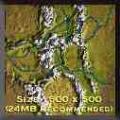About This File
Goal: Colorado's mining industry will pay high prices to any rail company able to ship their goods.
Author's Comments: The first rails were rolled into Colorado in late June 1867 by the Union Pacific. These first connections were an attempt to link Denver with the east. It wasn't until 1887 that the formidable rockies were penetrated in Colorado with a difficult grade laid by the Colorado Central railroad from Denver to Georgetown through Clear Creek Canyon to tap the silver mines there. Some of the highest rails in the country were laid from Georgetown through Silver Plume up to Waldorf near Mt. McClellan to service the Vidler mine. Here, the Argentine Central used Shays to climb to 13,110 feet to give the tourists a view of Grays and Torreys peaks. In the summer you can still ride the narrow gauge from Georgetown to Silver Plume.
There are two traditional routes through the Colorado rockies from Denver to Grand Junction. But dozens of passes over the divide have seen rails over the years. Most were short haul, short lived, financial disasters motivated by the rich mineral deposits here. The first Denver-Grand Junction connection went from Denver to Bailey to Como to Buena Vista through the continental divide via the Alpine Tunnel, then downhill through Gunnison, Montrose, Delta to Grand Junction. The other principal route is Denver to Granby via a tunnel under the Divide, then to Kremmling, Glenwood Springs and Grand Junction. This is the route that Amtrak uses today. In the map, I have provided two reasonable grades to replace the tunnels. One at Monarch Pass which is very near the Alpine tunnel, and a couple of switchbacks over the divide between Denver and Summit County to replace the tunnel that exists near Granby.
In this map, it will probably be necessary to haul minerals to keep your railroad afloat. Passenger revenues are low and towns are too far apart to make much money. Locate the mines and try to get their output to the smelters which were historically located in Leadville, Pueblo, and Denver. The cattle ranches in the Arkansas River valley between Salida and Leadville were an important source of food for the miners and early rail stations. And there was and is a significant agriculture industry in the southeast part of the state. Another good source of revenue will be anything related to construction like gravel, cement, lumber, and logs. Prices for these building commodities often skyrocketed when demand was high.


Recommended Comments
There are no comments to display.
Join the conversation
You can post now and register later. If you have an account, sign in now to post with your account.
Note: Your post will require moderator approval before it will be visible.